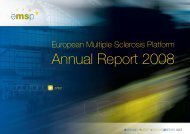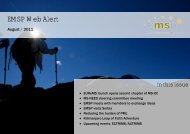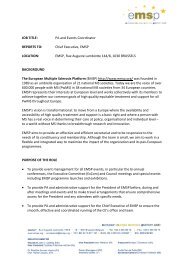Symptomatic Treatment of MS - European Multiple Sclerosis Platform
Symptomatic Treatment of MS - European Multiple Sclerosis Platform
Symptomatic Treatment of MS - European Multiple Sclerosis Platform
Create successful ePaper yourself
Turn your PDF publications into a flip-book with our unique Google optimized e-Paper software.
concepts, e.g. Bobath technique, Proprioceptive neuromuscular facilitation). Recently, an algorhythmus<br />
on existing treatment options has been developed under the auspices <strong>of</strong> the Academy <strong>of</strong> Neurologic<br />
Communication Disorders and Sciences (ANCDS) [Yorkston 2003; Spencer 2003]. <strong>Treatment</strong> consists <strong>of</strong><br />
� training <strong>of</strong> tactile and auditive perception on speech-related muscular motions<br />
� aware control <strong>of</strong> usually automated processes<br />
� inhibition <strong>of</strong> abnormal posture and movement<br />
� measures to normalize muscle tone, e.g. enhancement <strong>of</strong> flaccid muscle tone or its reduction in<br />
spastic elevation <strong>of</strong> tone<br />
� repetitive training <strong>of</strong> physiologic movements<br />
� bi<strong>of</strong>eedback.<br />
In spastic and ataxic dysarthria as the most common speech disorders, control <strong>of</strong> speech rate, voice<br />
emphasis and phrase shift, reduction <strong>of</strong> phrase length and increase <strong>of</strong> voice power are the mainstays <strong>of</strong><br />
treatment [Merson 1998; Miller Sorensen 2000].<br />
Controlled studies are still lacking for <strong>MS</strong>. In patients suffering from Parkinson´s disease a beneficial effect<br />
<strong>of</strong> this treatment on loudness and dysarthria could be demonstrated but no superiority <strong>of</strong> a special technique<br />
[Deane 2001; Deane 2002; de Swart 2003]. In most <strong>of</strong> the Parkinson patients with hypokinetic<br />
dysarthria the„Lee Silverman Voice <strong>Treatment</strong>“ (LSVT) had been used which also may be effective in <strong>MS</strong><br />
patients [Sapir 2001].<br />
However fatigue can interfere with results when this technique is used in <strong>MS</strong> patients. In an evidencebased<br />
evaluation it could be demonstrated that bi<strong>of</strong>eedback can be effective in changing physiologic<br />
variables. However, the relationship between these changes and speech production or communicative<br />
participation has yet to be clearly established [Yorkston 2003].<br />
PROSTHETIC AND OTHER TECHNICAL AIDS<br />
In patients with nasal speech due to impaired function <strong>of</strong> the s<strong>of</strong>t palatine the velum can be elevated by<br />
a velum prosthesis fixated to the teeth to ameliorate hypernasality [Vogel 1987].<br />
Technical aids like a pacing board, graduated sticks or a metronome can help to control speech velocity<br />
whereas a delayed auditory feedback unit may reduce it.“White”(background) noise presented via headphones<br />
<strong>of</strong>ten leads to a spontaneous increase <strong>of</strong> loudness (Lombard effect).<br />
Alternatively electronical voice amplifiers may be used. As with any speech behavioral techniques, the<br />
effectiveness <strong>of</strong> these devices cannot be estimated sufficiently due to the small number <strong>of</strong> patients<br />
published. Nevertheless in an ANCDS review it was stated that these devices“may improve speech loudness<br />
and, in most cases, intelligibility <strong>of</strong> speech in individuals with hypokinetic dysarthria” [Yorkston<br />
2003].<br />
35 E<strong>MS</strong>P, <strong>Symptomatic</strong> <strong>Treatment</strong> <strong>of</strong> <strong>Multiple</strong> <strong>Sclerosis</strong>, December 2006 - revised in April 2008






